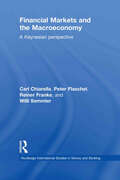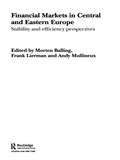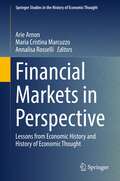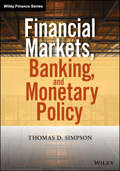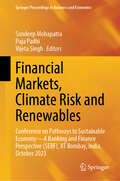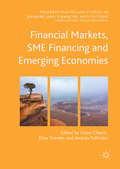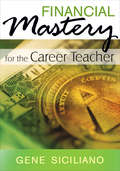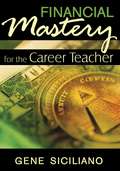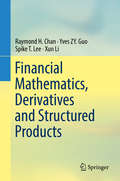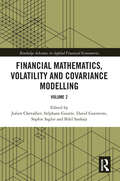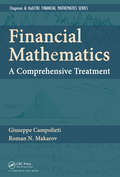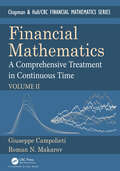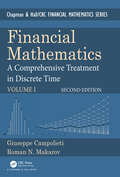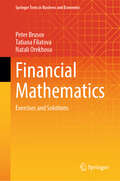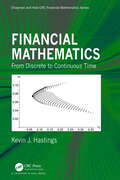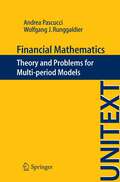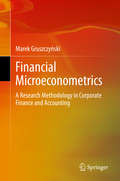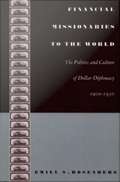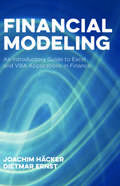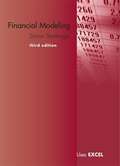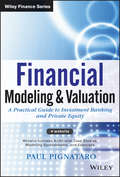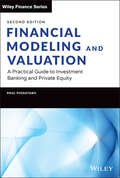- Table View
- List View
Financial Markets and the Macroeconomy: A Keynesian Perspective (Routledge International Studies in Money and Banking)
by Peter Flaschel Carl Chiarella Willi Semmler Reiner FrankeThe financial instability and its spillover to the real sector have become a great challenge to macro-economic theory. The book takes a Keynesian theoretical perspective, representing an attempt to revive what Keynes stressed in his General Theory, namely the role of the financial market in macroeconomic outcomes. Although this book is inspired and motivated by the Asian currency and financial crises in the years 1997-8 and the experiences of the currently evolving U.S. financial disruptions, it also focuses on reviving a modeling tradition that provides a theoretical framework that throws light on recent financial market episodes and disturbances and their macroeconomic effects. It brings to the forefront, as Keynes has suggested, the role of financial market stability for growth and macroeconomics. It criticizes theories that see economic disruptions and shocks rooted solely in the real side of the economy. It stresses the financial real interaction as the major source for macroeconomic instability and disruptions. This important new book from a group of Keynesian, but nonetheless technically oriented economists would be of most interest to specialists and graduate students in macroeconomics and financial economics, especially those with an interest in US and European financial markets, emerging market analysis, and dynamic economic modeling.
Financial Markets for Commodities
by Joel PriolonAgricultural, energy or mineral commodities are traded internationally in two market categories: physical markets and financial markets. More specifically, on the financial markets, contracts are negotiated, the price of which depends on the price of a commodity. These contracts are called derivatives (futures, options contracts, swaps). This book presents, on the one hand, the characteristics of these derivatives and the markets on which they are traded and, on the other hand, those transactions that typically combine an action on the physical market and a transaction on the corresponding financial market. The understanding of commodity financial markets mainly relies on the resources of economic analysis, especially the financial economy, because the use of this discipline is essential to understanding the major operations that are conducted daily by the operators of these markets: traders, producers, processors, financiers.
Financial Markets in Central and Eastern Europe: Stability and Efficiency (Routledge Studies in the European Economy)
by Andy Mullineux Morten Balling Frank LiermanThe countries of Central and Eastern Europe have been through a profound transition process for more than a decade now. The financial sectors and markets in the region have been subject to major structural reforms including privatization, liberalization and the acquisition by foreign banks of controlling interests in local financial institutions.This important new book includes papers that chart this process. Topics discussed include the implications of future EU membership, and the strategies pursued by the World Bank and International Monetary Fund.
Financial Markets in Perspective: Lessons from Economic History and History of Economic Thought (Springer Studies in the History of Economic Thought)
by Arie Arnon Maria Cristina Marcuzzo Annalisa RosselliThis book examines financial markets from a historical perspective. Bringing together contributions from leading historians of economic thought, economists and economic historians, it offers an integrated approach and reflects on the workings of financial markets, their impact on and relation with the rest of the economy and how their role was and is understood by economics. The contributions cover topics such as classical and modern economic thinking on financial markets and institutions, as well as financial models and innovations, and also present case studies on financial history and on policy issues. The historical perspective leads to a representation of markets not as abstract and timeless mechanisms but as institutions populated by a diversity of agents, subject to rules and customs, and influenced by scientific developments and economic theories.
Financial Markets, Banking, and Monetary Policy
by Thomas D. SimpsonPraise for Financial Markets, Banking, and MonetaryPolicy"A lucid treatment that takes on board shadow-banking,Dodd-Frank, the zero lower bound, and forward guidance. In short,all the key post-crisis issues."--Anil Kashyap, Edward Eagle Brown Professor of Economicsand Finance, University of Chicago"The financial sector is a vital component of the USeconomic machinery. The Federal Reserve works within this sector topromote its congressional mandates of maximum employment and lowinflation. Unfortunately, the contribution of the financial systemto the economy's performance is not well understood. Studentsof standard college courses on money, banking, and monetary policyoften find that the textbooks have not kept pace with the evolutionof the financial sector, including the rise of securitized financeand the Federal Reserve's evolving monetary operations. TomSimpson's book represents a huge step forward in this regard.His comprehensive exposition of the essential parts of thefinancial system and modern explanation of how the Federal Reservesupports the economy gives readers a much better understanding ofthe US financial system and the Federal Reserve."--James Glassman, Managing Director and Head Economist forthe Commercial Bank, JPMorgan Chase & Co."Financial Markets, Banking, and Monetary Policy byTom Simpson provides a comprehensive introduction to the financialsystem, including the markets, institutions, and mechanisms offinance, as well as the role of the Federal Reserve and monetarypolicy. The economic principles underlying finance are woventhrough the chapters, and the book includes an insightfulintroduction into the causes of and responses to the recentfinancial crisis. Tom Simpson has had a front-row seat on financialdevelopments in recent decades and has written a book that providesan ideal introduction to the financial system and monetarypolicy."--Dan Sichel, Professor of Economics, Wellesley College
Financial Markets, Climate Risk and Renewables: Conference on Pathways to Sustainable Economy—A Banking and Finance Perspective (SEBF), IIT Bombay, India, October 2023 (Springer Proceedings in Business and Economics)
by Sandeep Mohapatra Puja Padhi Vijeta SinghThis volume offers a comprehensive examination of how innovative financial strategies can address critical environmental and social challenges globally. Organized around five key themes—financial institutions fostering financial stability; volatility in financial markets; inclusive development: MSMEs, and microfinance; financial innovation for sustainability: ESG and climate finance; and fintech—it presents pioneering studies that provide deep insights into the intersection of finance and sustainable development. The book fills the literature gap that concerns sustainable economic development, financial markets, and institutions and provides several high-quality studies that focus on sustainable economic development, financial markets, renewables, and climate risks. Contributions are by scholars from diverse fields and include practical policy recommendations. The book is an essential resource for academics, policymakers, and professionals dedicated to leveraging financial innovations for sustainable development. By offering a comprehensive examination of formal and informal financial institutions, digital finance, economic development, and green sustainability, this book not only advances knowledge but also provides practical solutions to build a resilient and inclusive global economy.
Financial Markets, SME Financing and Emerging Economies
by Giusy Chesini Elisa Giaretta Andrea PaltrinieriThis book investigates small and medium sized enterprises (SMEs) access to credit, the earning quality, and the cost of debt in the European Union. It also examines two important risk measures in financial markets: the volatility index (VIX) and Credit Default Swaps (CDS). Finally, it deep dives inside one of the most important emerging markets, China, to assess monetary policy and the relationship between financial institutions and real estate firms. This work will appeal to both academics and practitioners in the areas of SME financing, financial markets and emerging economies.
Financial Mastery for the Career Teacher
by Gene SicilianoWritten by a financial advisor, this comprehensive yet concise primer is ideal for educators balancing modest salaries with skyrocketing expenses in challenging economic times.
Financial Mastery for the Career Teacher
by Gene SicilianoThe money management book that no educator can afford to be without!Teaching has many rewards, including the opportunity to change young people's lives and make a meaningful difference in a community every day. However, despite the important work they do, teachers often find themselves struggling to survive on a teaching salary.Written by certified financial advisor and award-winning speaker Gene Siciliano, Financial Mastery for the Career Teacher is a comprehensive yet concise primer for educators balancing modest salaries with skyrocketing expenses in challenging economic times. From basic money management to advanced investments, the author covers the personal finance questions and concerns that all educators face, including: Providing for a family on a teacher's salary Making every dollar stretch Buying a home Managing debt Planning for retirement Understanding and purchasing insurance Investing in the stock market or real estate Taxes and tax planningThis book offers tips and guidelines for all teachers, from those just starting out to long-time veterans. Money concerns shouldn't distract you from your teaching. Start planning your financial future now so you can have a fulfilling career as a teacher and still come out ahead!
Financial Mathematics For Actuaries (Second Edition)
by Wai-Sum Chan Yiu-Kuen TseFinancial Mathematics for Actuaries is a textbook for students in actuarial science, quantitative finance, financial engineering and quantitative risk management and is designed for a one-semester undergraduate course. <P><P> Covering the theories of interest rates, with applications to the evaluation of cash flows, the pricing of fixed income securities and the management of bonds, this textbook also contains numerous examples and exercises and extensive coverage of various Excel functions for financial calculation. Discussions are linked to real financial market data, such as historical term structure, and traded financial securities. <P><P> The topics discussed in this book are essential for actuarial science students. They are also useful for students in financial markets, investments and quantitative finance. Students preparing for examinations in financial mathematics with various professional actuarial bodies will also find this book useful for self-study. <P><P> In this second edition, the recent additions in the learning objectives of the Society of Actuaries Exam FM have been covered.
Financial Mathematics, Derivatives and Structured Products
by Raymond H. Chan Spike T. Lee Xun Li Yves ZY. GuoThis book introduces readers to the financial markets, derivatives, structured products and how the products are modelled and implemented by practitioners. In addition, it equips readers with the necessary knowledge of financial markets needed in order to work as product structurers, traders, sales or risk managers. As the book seeks to unify the derivatives modelling and the financial engineering practice in the market, it will be of interest to financial practitioners and academic researchers alike. Further, it takes a different route from the existing financial mathematics books, and will appeal to students and practitioners with or without a scientific background. The book can also be used as a textbook for the following courses: • Financial Mathematics (undergraduate level) • Stochastic Modelling in Finance (postgraduate level) • Financial Markets and Derivatives (undergraduate level) • Structured Products and Solutions (undergraduate/postgraduate level)
Financial Mathematics, Derivatives and Structured Products
by Raymond H. Chan Spike T. Lee Xun Li Yves ZY. GuoThis book introduces readers to the financial markets, derivatives, structured products and how the products are modelled and implemented by practitioners. In addition, it equips readers with the necessary knowledge of financial markets needed in order to work as product structurers, traders, sales or risk managers.This second edition substantially extends, updates and clarifies the previous edition. New materials and enhanced contents include, but not limited to, the role of central counterparties for derivatives transactions, the reference rates to replace LIBOR, risk-neutral modelling for futures and forward, discussions and analysis on risk-neutral framework and numéraires, discrete dividend modelling, variance reduction techniques for Monte Carlo method, finite difference method analysis, tree method, FX modelling, multi-name credit derivatives modelling, local volatility model, forward variance model and local-stochastic volatility model to reflect market practice.As the book seeks to unify the derivatives modelling and the financial engineering practice in the market, it will be of interest to financial practitioners and academic researchers alike. The book can also be used as a textbook for the following courses:• Financial Mathematics (undergraduate level)• Stochastic Modelling in Finance (postgraduate level)• Financial Markets and Derivatives (undergraduate level)• Structured Products and Solutions (undergraduate/postgraduate level)
Financial Mathematics, Volatility and Covariance Modelling: Volume 2 (Routledge Advances in Applied Financial Econometrics)
by Julien Chevallier Stéphane Goutte David Guerreiro Sophie Saglio Bilel SanhajiThis book provides an up-to-date series of advanced chapters on applied financial econometric techniques pertaining the various fields of commodities finance, mathematics & stochastics, international macroeconomics and financial econometrics. Financial Mathematics, Volatility and Covariance Modelling: Volume 2 provides a key repository on the current state of knowledge, the latest debates and recent literature on financial mathematics, volatility and covariance modelling. The first section is devoted to mathematical finance, stochastic modelling and control optimization. Chapters explore the recent financial crisis, the increase of uncertainty and volatility, and propose an alternative approach to deal with these issues. The second section covers financial volatility and covariance modelling and explores proposals for dealing with recent developments in financial econometrics This book will be useful to students and researchers in applied econometrics; academics and students seeking convenient access to an unfamiliar area. It will also be of great interest established researchers seeking a single repository on the current state of knowledge, current debates and relevant literature.
Financial Mathematics: A Comprehensive Treatment (Textbooks in Mathematics)
by Roman N. Makarov Giuseppe CampolietiVersatile for Several Interrelated Courses at the Undergraduate and Graduate Levels <P><P> Financial Mathematics: A Comprehensive Treatment provides a unified, self-contained account of the main theory and application of methods behind modern-day financial mathematics. Tested and refined through years of the authors’ teaching experiences, the book encompasses a breadth of topics, from introductory to more advanced ones. <P><P> Accessible to undergraduate students in mathematics, finance, actuarial science, economics, and related quantitative areas, much of the text covers essential material for core curriculum courses on financial mathematics. Some of the more advanced topics, such as formal derivative pricing theory, stochastic calculus, Monte Carlo simulation, and numerical methods, can be used in courses at the graduate level. Researchers and practitioners in quantitative finance will also benefit from the combination of analytical and numerical methods for solving various derivative pricing problems. <P><P> With an abundance of examples, problems, and fully worked out solutions, the text introduces the financial theory and relevant mathematical methods in a mathematically rigorous yet engaging way. Unlike similar texts in the field, this one presents multiple problem-solving approaches, linking related comprehensive techniques for pricing different types of financial derivatives. The book provides complete coverage of both discrete- and continuous-time financial models that form the cornerstones of financial derivative pricing theory. It also presents a self-contained introduction to stochastic calculus and martingale theory, which are key fundamental elements in quantitative finance.
Financial Mathematics: A Comprehensive Treatment in Continuous Time Volume II (Textbooks in Mathematics)
by Roman N. Makarov Giuseppe CampolietiThe book has been tested and refined through years of classroom teaching experience. With an abundance of examples, problems, and fully worked out solutions, the text introduces the financial theory and relevant mathematical methods in a mathematically rigorous yet engaging way. This textbook provides complete coverage of continuous-time financial models that form the cornerstones of financial derivative pricing theory. Unlike similar texts in the field, this one presents multiple problem-solving approaches, linking related comprehensive techniques for pricing different types of financial derivatives. Key features: In-depth coverage of continuous-time theory and methodology Numerous, fully worked out examples and exercises in every chapter Mathematically rigorous and consistent, yet bridging various basic and more advanced concepts Judicious balance of financial theory and mathematical methods Guide to Material This revision contains: Almost 150 pages worth of new material in all chapters A appendix on probability theory An expanded set of solved problems and additional exercises Answers to all exercises This book is a comprehensive, self-contained, and unified treatment of the main theory and application of mathematical methods behind modern-day financial mathematics. The text complements Financial Mathematics: A Comprehensive Treatment in Discrete Time, by the same authors, also published by CRC Press.
Financial Mathematics: A Comprehensive Treatment in Discrete Time (Chapman and Hall/CRC Financial Mathematics Series)
by Roman N. Makarov Giuseppe CampolietiThe book has been tested and refined through years of classroom teaching experience. With an abundance of examples, problems, and fully worked out solutions, the text introduces the financial theory and relevant mathematical methods in a mathematically rigorous yet engaging way. This textbook provides complete coverage of discrete-time financial models that form the cornerstones of financial derivative pricing theory. Unlike similar texts in the field, this one presents multiple problem-solving approaches, linking related comprehensive techniques for pricing different types of financial derivatives. Key features: In-depth coverage of discrete-time theory and methodology. Numerous, fully worked out examples and exercises in every chapter. Mathematically rigorous and consistent yet bridging various basic and more advanced concepts. Judicious balance of financial theory, mathematical, and computational methods. Guide to Material. This revision contains: Almost 200 pages worth of new material in all chapters. A new chapter on elementary probability theory. An expanded the set of solved problems and additional exercises. Answers to all exercises. This book is a comprehensive, self-contained, and unified treatment of the main theory and application of mathematical methods behind modern-day financial mathematics. Table of Contents List of Figures and Tables Preface I Introduction to Pricing and Management of Financial Securities 1 Mathematics of Compounding2 Primer on Pricing Risky Securities 3 Portfolio Management 4 Primer on Derivative Securities II Discrete-Time Modelling 5 Single-Period Arrow–Debreu Models 6 Introduction to Discrete-Time Stochastic Calculus 7 Replication and Pricing in the Binomial Tree Model 8 General Multi-Asset Multi-Period Model Appendices A Elementary Probability Theory B Glossary of Symbols and Abbreviations C Answers and Hints to Exercises References Index Biographies Giuseppe Campolieti is Professor of Mathematics at Wilfrid Laurier University in Waterloo, Canada. He has been Natural Sciences and Engineering Research Council postdoctoral research fellow and university research fellow at the University of Toronto. In 1998, he joined the Masters in Mathematical Finance as an instructor and later as an adjunct professor in financial mathematics until 2002. Dr. Campolieti also founded a financial software and consulting company in 1998. He joined Laurier in 2002 as Associate Professor of Mathematics and as SHARCNET Chair in Financial Mathematics. Roman N. Makarov is Associate Professor and Chair of Mathematics at Wilfrid Laurier University. Prior to joining Laurier in 2003, he was an Assistant Professor of Mathematics at Siberian State University of Telecommunications and Informatics and a senior research fellow at the Laboratory of Monte Carlo Methods at the Institute of Computational Mathematics and Mathematical Geophysics in Novosibirsk, Russia.
Financial Mathematics: Exercises and Solutions (Springer Texts in Business and Economics)
by Peter Brusov Tatiana Filatova Natali OrekhovaThis textbook is designed to facilitate a thorough learning for students of financial mathematics. It includes exercises and theoretical questions across seven chapters: Interest Theory, Financial Flows and Annuities, Profitability and Risk of Financial Operations, Portfolio Analysis, Bonds, Modigliani-Miller Theory, and Brusov-Filatova-Orekhova Theory. The last two chapters are dedicated to modern theories of capital structure, including problems and tasks. More than 130 detailed solutions are provided to help students solve the assignments in the textbook. This textbook is suitable for undergraduate and graduate students in all financial and economic fields, including finance and credit, accounting and auditing, taxes, insurance, and international economic relations. It is also useful for professionals in financial and economic specialties, including financial analysts, as well as anyone interested in mastering quantitative methods in finance and economics.
Financial Mathematics: From Discrete to Continuous Time (Chapman and Hall/CRC Financial Mathematics Series)
by Kevin J. HastingsFinancial Mathematics: From Discrete to Continuous Time is a study of the mathematical ideas and techniques that are important to the two main arms of the area of financial mathematics: portfolio optimization and derivative valuation. The text is authored for courses taken by advanced undergraduates, MBA, or other students in quantitative finance programs. The approach will be mathematically correct but informal, sometimes omitting proofs of the more difficult results and stressing practical results and interpretation. The text will not be dependent on any particular technology, but it will be laced with examples requiring the numerical and graphical power of the machine. The text illustrates simulation techniques to stand in for analytical techniques when the latter are impractical. There will be an electronic version of the text that integrates Mathematica functionality into the development, making full use of the computational and simulation tools that this program provides. Prerequisites are good courses in mathematical probability, acquaintance with statistical estimation, and a grounding in matrix algebra. The highlights of the text are: A thorough presentation of the problem of portfolio optimization, leading in a natural way to the Capital Market Theory Dynamic programming and the optimal portfolio selection-consumption problem through time An intuitive approach to Brownian motion and stochastic integral models for continuous time problems The Black-Scholes equation for simple European option values, derived in several different ways A chapter on several types of exotic options Material on the management of risk in several contexts
Financial Mathematics: Theory and Problems for Multi-period Models
by Wolfgang J. Runggaldier Andrea PascucciWith the Bologna Accords a bachelor-master-doctor curriculum has been introduced in various countries with the intention that students may enter the job market already at the bachelor level. Since financial Institutions provide non negligible job opportunities also for mathematicians, and scientists in general, it appeared to be appropriate to have a financial mathematics course already at the bachelor level in mathematics. Most mathematical techniques in use in financial mathematics are related to continuous time models and require thus notions from stochastic analysis that bachelor students do in general not possess. Basic notions and methodologies in use in financial mathematics can however be transmitted to students also without the technicalities from stochastic analysis by using discrete time (multi-period) models for which general notions from Probability suffice and these are generally familiar to students not only from science courses, but also from economics with quantitative curricula. There do not exists many textbooks for multi-period models and the present volume is intended to fill in this gap. It deals with the basic topics in financial mathematics and, for each topic, there is a theoretical section and a problem section. The latter includes a great variety of possible problems with complete solution.
Financial Microeconometrics: A Research Methodology in Corporate Finance and Accounting
by Marek GruszczyńskiThis book explores new topics in modern research on empirical corporate finance and applied accounting, especially the econometric analysis of microdata. Dubbed “financial microeconometrics” by the author, this concept unites both methodological and applied approaches. The book examines how quantitative methods can be applied in corporate finance and accounting research in order to predict companies getting into financial distress. Presented in a clear and straightforward manner, it also suggests methods for linking corporate governance to financial performance, and discusses what the determinants of accounting disclosures are. Exploring these questions by way of numerous practical examples, this book is intended for researchers, practitioners and students who are not yet familiar with the variety of approaches available for data analysis and microeconometrics.“This book on financial microeconometrics is an excellent starting point for research in corporate finance and accounting. In my view, the text is positioned between a narrative and a scientific treatise. It is based on a vast amount of literature but is not overloaded with formulae. My appreciation of financial microeconometrics has very much increased. The book is well organized and properly written. I enjoyed reading it.” Wolfgang Marty, Senior Investment Strategist, AgaNola AG
Financial Missionaries to the World: The Politics and Culture of Dollar Diplomacy 1900-1930
by Emily S. RosenbergWinner of the Society for Historians of American Foreign Relations Robert H. Ferrell Book Prize Financial Missionaries to the World establishes the broad scope and significance of "dollar diplomacy"--the use of international lending and advising--to early-twentieth-century U. S. foreign policy. Combining diplomatic, economic, and cultural history, the distinguished historian Emily S. Rosenberg shows how private bank loans were extended to leverage the acceptance of American financial advisers by foreign governments. In an analysis striking in its relevance to contemporary debates over international loans, she reveals how a practice initially justified as a progressive means to extend "civilization" by promoting economic stability and progress became embroiled in controversy. Vocal critics at home and abroad charged that American loans and financial oversight constituted a new imperialism that fostered exploitation of less powerful nations. By the mid-1920s, Rosenberg explains, even early supporters of dollar diplomacy worried that by facilitating excessive borrowing, the practice might induce the very instability and default that it supposedly worked against. "[A] major and superb contribution to the history of U. S. foreign relations. . . . [Emily S. Rosenberg] has opened up a whole new research field in international history. "--Anders Stephanson, Journal of American History "[A] landmark in the historiography of American foreign relations. "--Melvyn P. Leffler, author of A Preponderence of Power: National Security, the Truman Administration, and the Cold War "Fascinating. "--Christopher Clark, Times Literary Supplement
Financial Modeling
by Joachim Häcker Dietmar ErnstNachvollziehbare Modelle zur Beurteilung komplexer Finanzprodukte. Die Autoren bieten Studenten einen anwendungsorientierten Leitfaden zu den zentralen Themenkomplexen Corporate Finance, Derivate und Portfoliomanagement. Zwei Workshops zu Microsoft Excel(r) und der Programmiersprache VBA(r) komplettieren das finanzwirtschaftliche Know-how. Der Kurscharakter des Buches und die praxisnahen Beispiele, die zusatzlich als Download-Angebot zur Verfugung stehen, ermoglichen ein schnelles und interaktives Lernen. Als Nachschlagewerk leistet der Band auch Praktikern wertvolle Dienste. "
Financial Modeling (3rd Edition)
by Simon BenningaToo often, finance courses stop short of making a connection between textbook finance and the problems of real-world business. Financial Modeling bridges this gap between theory and practice by providing a nuts-and-bolts guide to solving common financial models with spreadsheets. Simon Benninga takes the reader step by step through each model, showing how it can be solved using Microsoft Excel. The long-awaited third edition of this standard text maintains the "cookbook" features and Excel dependence that have made the first and second editions so popular. It also offers significant new material, with new chapters covering such topics as bank valuation, the Black-Litterman approach to portfolio optimization, Monte Carlo methods and their applications to option pricing, and using array functions and formulas. Other chapters, including those on basic financial calculations, portfolio models, calculating the variance-covariance matrix,and generating random numbers, have been revised, with many offering substantially new and improved material. Other areas covered include financial statement modeling, leasing, standard portfolio problems, value at risk (VaR), real options, duration and immunization, and term structure modeling. Technical chapters treat such topics as data tables, matrices, the Gauss-Seidel method, and tips for using Excel. The last section of the text covers the Visual Basic for Applications (VBA) techniques needed for the book. The accompanying CD contains Excel worksheets and solutions to end-of-chapter exercises.
Financial Modeling and Valuation
by Paul PignataroWritten by the Founder and CEO of the prestigious New York School of Finance, this book schools you in the fundamental tools for accurately assessing the soundness of a stock investment. Built around a full-length case study of Wal-Mart, it shows you how to perform an in-depth analysis of that company's financial standing, walking you through all the steps of developing a sophisticated financial model as done by professional Wall Street analysts. You will construct a full scale financial model and valuation step-by-step as you page through the book.When we ran this analysis in January of 2012, we estimated the stock was undervalued. Since the first run of the analysis, the stock has increased 35 percent. Re-evaluating Wal-Mart 9months later, we will step through the techniques utilized by Wall Street analysts to build models on and properly value business entities.Step-by-step financial modeling - taught using downloadable Wall Street models, you will construct the model step by step as you page through the book.Hot keys and explicit Excel instructions aid even the novice excel modeler.Model built complete with Income Statement, Cash Flow Statement, Balance Sheet, Balance Sheet Balancing Techniques, Depreciation Schedule (complete with accelerating depreciation and deferring taxes), working capital schedule, debt schedule, handling circular references, and automatic debt pay downs.Illustrative concepts including detailing model flows help aid in conceptual understanding.Concepts are reiterated and honed, perfect for a novice yet detailed enough for a professional.Model built direct from Wal-Mart public filings, searching through notes, performing research, and illustrating techniques to formulate projections.Includes in-depth coverage of valuation techniques commonly used by Wall Street professionals.Illustrative comparable company analyses - built the right way, direct from historical financials, calculating LTM (Last Twelve Month) data, calendarization, and properly smoothing EBITDA and Net Income.Precedent transactions analysis - detailing how to extract proper metrics from relevant proxy statementsDiscounted cash flow analysis - simplifying and illustrating how a DCF is utilized, how unlevered free cash flow is derived, and the meaning of weighted average cost of capital (WACC)Step-by-step we will come up with a valuation on Wal-MartChapter end questions, practice models, additional case studies and common interview questions (found in the companion website) help solidify the techniques honed in the book; ideal for universities or business students looking to break into the investment banking field.
Financial Modeling and Valuation: A Practical Guide to Investment Banking and Private Equity (Wiley Finance)
by Paul PignataroThe fully revised new edition of the best-selling guide to using financial models to determine if a stock is over or undervalued Written by the founder and CEO of the world-renowned New York School of Finance, Financial Modeling and Valuation provides clear and systematic guidance on accurately evaluating the soundness of a stock investment. This invaluable handbook equips investors with the tools necessary for understanding the underlying fundamentals of a rational investment and for making smarter investment decisions in any market environment. Built around an in-depth case study of global retail leader Amazon, this fully updated Second Edition shows you how to analyze the financial standing of a company using the methods of Wall Street professionals. Step-by-step, you will learn to build the core three statements—income statement, cash flow statement, and balance sheet—as well as the three major supporting schedules required for complete company valuation and analysis. All line items are explained in clear language and include real-world tips and techniques for using them as tools for valuing and managing a business. This must-have guide: Features new and in-depth case studies based on Amazon that simulate real-world modelling and valuation Explains valuation techniques such as illustrative comparable company analysis, precedent transactions analysis, and discounted cash flow analysis Covers all essential applications of a model, including pricing a stock, raising debt, and raising equity Includes an introductory section describing the recent and dramatic shift of the entire retail industry Provides end-of-chapter questions, downloadable practice models, additional case studies, and common interview questions via a companion website Financial Modeling and Valuation: A Practical Guide to Investment Banking and Private Equity, Second Edition is essential reading for finance professionals, venture capitalists, individual investors, and students in investment banking and related degree programs in finance.
